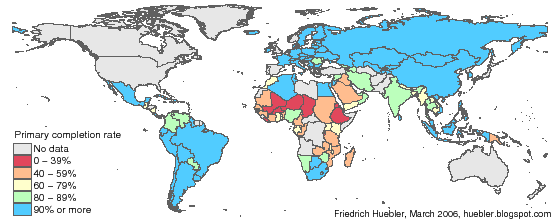Definition: "The primary completion rate is the ratio of the total number of students successfully completing (or graduating from) the last year of primary school in a given year to the total number of children of official graduation age in the population." (United Nations Development Group. 2003. Indicators for monitoring the Millennium Development Goals: Definitions, rationale, concepts and sources. New York: United Nations.)
- Primary completion rate = Number of primary school graduates / Number of children of primary school graduation age
- Gross intake rate to last grade of primary = (Number of children in last primary grade – Number of repeaters) / Number of children of entrance age to last primary grade
The map below indicates the primary completion rate in each country for which data was available. The top group includes all countries with a primary completion rate at or above 90 percent. The primary completion rate can have values above 100 percent, which can be a symptom of late entry, grade repetition, or of an enrollment push at some point in the past, perhaps as a consequence of a school enrollment campaign. In the UIS database, 38 countries have values above 100 percent but in the long run the primary completion rate can be expected to stabilize at 100 percent.
Primary completion rate, 2002/2003

Data source: UNESCO Institute for Statistics (UIS). 2005. Global Education Digest 2005. Montreal: UIS.
In ten countries, all in sub-Saharan Africa, the primary completion rate is below 40 percent: Burkina Faso, Burundi, Chad, Djibouti, Eritrea, Ethiopia, Guinea-Bissau, Liberia, Mali, and Niger. In 19 countries, the primary completion rate is between 40 and 59 percent, in 20 it is between 60 and 79 percent, and in 26 countries it is between 80 and 89 percent. 91 countries have primary completion rates at or above 90 percent.
The global average for the primary completion rate is 84.5 percent (see the table below). Boys (86.4 percent) are more likely to complete their primary education than girls (82.3 percent). When countries are grouped by UNICEF region, the highest primary completion rates are observed in industrialized countries (100.5 percent), Latin America and the Caribbean (97.2 percent), East Asia and the Pacific (96.6 percent), and in Eastern Europe and the Commonwealth of Independent States (93.8 percent). Countries in these regions have already reached or are close to the goal of universal primary education.
Lower primary completion rates are observed in Eastern and Southern Africa (59.5 percent), West and Central Africa (64.8 percent), the Middle East and North Africa (75.4 percent), and South Asia (81.6 percent). The biggest gender disparity exists in West and Central Africa, where the primary completion rate of boys is 14.6 percent above that of girls. High gender gaps also exist in Eastern and Southern Africa (7.6 percent), the Middle East and North Africa (7.5 percent), and South Asia (6.3 percent). Latin America and the Caribbean is the only region where girls are more likely to complete primary education than boys, but the gap is relatively small (2.6 percent).
Primary completion rate, 2002/03
| Region | Primary completion rate (%) | ||
| Male | Female | Total | |
| East Asia, Pacific | 96.6 | 96.6 | 96.6 |
| Eastern and Southern Africa | 63.3 | 55.7 | 59.5 |
| Eastern Europe, CIS | 96.7 | 95.4 | 93.8 |
| Industrialized countries | 100.7 | 100.7 | 100.5 |
| Latin America, Caribbean | 95.9 | 98.5 | 97.2 |
| Middle East, North Africa | 79.0 | 71.5 | 75.4 |
| South Asia | 84.6 | 78.3 | 81.6 |
| West and Central Africa | 72.0 | 57.4 | 64.8 |
| World | 86.4 | 82.3 | 84.5 |
Note: Regional values are weighted by each country's population of primary school age.
Friedrich Huebler, 27 March 2006, Creative Commons License